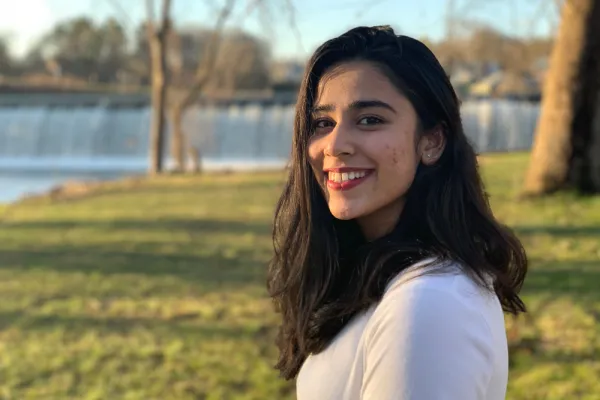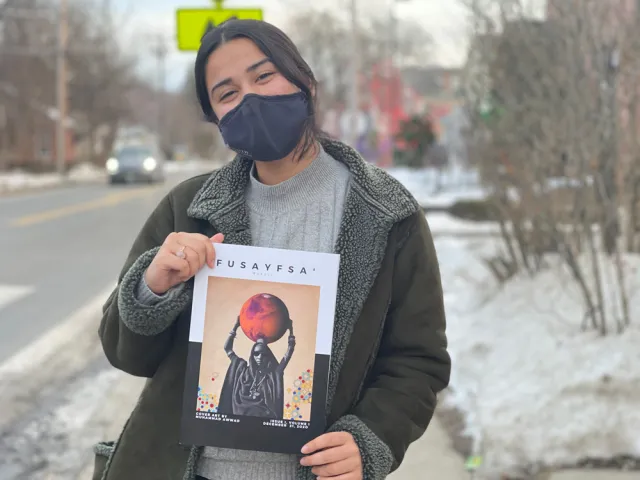Challenging Assumptions About North Africa West Asia
Research & Inquiry
Published February 5, 2021
Ever a planner, Manal Fatima ’23, a quantitative economics and Middle East studies double major, has always known where her academic interests lie. While she enjoys delving into discussions in class and completing independent research, she also has realized a need to bring a like-minded community together to address a troubling theme that often cropped up in her studies: the many misconceptions and prejudices surrounding the region of North Africa West Asia.
“We all benefit from interacting and communicating with peers from diverse backgrounds,” Fatima says, and so she launched an online journal, aptly called Fusayfsa’—“Mosaic” in Arabic—aimed at breaking down harmful biases. A collaboration among faculty, Smith students, and peers from the Five College Consortium, the inaugural issue of Fusayfsa’ launched in Fall 2020.
“Fusayfsa’ is an amazing initiative by students to create an independent, inclusive platform for students themselves to showcase their research and to engage one another on the most critical issues shaping the future of the region,” notes Steven Heydemann, Janet Wright Ketcham 1953 Professor in Middle East Studies.
Heydemann, who is also the director of Smith’s program in Middle East studies, served as a faculty adviser on the publication. “To create this beautifully produced online journal, with stunning graphics and such impressive content, was a huge effort,” Heydemann says.
Fatima recently reflected on Fusayfsa’s beginnings and shared her hopes for the journal’s future.
What prompted you to start Fusayfsa’?
I was looking for a space where I and other students could facilitate and exchange thoughts on matters of concern and where we can address misconceptions by interacting with people from the region, asking experts in the field the questions that bother us, and by initiating discussions.
I began thinking about it in the second semester of my first year. The plan was solidified after my summer internship with the National Council on U.S.-Arab Relations, where I gained more knowledge about the region and got to listen to thought-provoking lectures from some wonderful speakers. I looked at some other universities and their publications, and finally, in the summer of 2020, I talked with Professor Heydemann, who encouraged me and asked me to go ahead with drafting a proposal.
Were any personal experiences motivating factors in creating the journal?
I have traveled to West Asia a couple of times, and the experience I had there, in particular my interactions with the people, undoubtedly contributed in some ways toward creating Fusayfsa’. During my travels, when I connected with the locals—formed friendships with some, exchanged a few smiles with others, and breathed in that Zafran-filled air—I saw beyond the mess of international politics. After that, whenever I would encounter any generalized negative associations with the region or its people, I definitely felt a stronger urge to at least make an effort and do something about it.
Being a Muslim and belonging to a minority sect, I have been highlighted for holding differing beliefs in my own country and have been lumped together and stereotyped internationally. I didn’t like it and I don’t want others to experience it.
How were you able to connect with others who had similar ideas and concerns, turning Fusayfsa’ into a tangible publication?
To be honest, when Fusayfsa’ was only a thought in my mind, I was a bit hesitant and unsure about whether I should go ahead with it. I presented my idea to Professor Heydemann and got immense support. Immediately afterward, I made a Google form, combined it with an acceptable looking poster, and flooded every possible social media outlet and mailing list. With every new response to my form, I would jump around in my room. It was not only turning my plans into reality, but for the first time, I was truly embracing Smith College and the Smith community as an international student. I was a Smithie in action.
The response was really encouraging. I had around 30 people on my team and a couple of emails in my inbox showing support and interest. I pulled all-nighters, got frustrated, and cried, but not once did I think of abandoning the plan. I celebrated every submission. And when I held the first printed copy of Fusayfsa’, it was truly a sigh of relief.
What was the process of planning and assembling the journal like? How did you choose which matters to address in the inaugural issue of Fusayfsa’?
We came up with ideas together. Since it was the inaugural issue, we thought it better to start with an article on “What is the Middle East?”
During meetings, we were divided on what to call the region—Middle East or West Asia—and this led to a roundtable discussion where team members engaged in thoughtful conversation to decide how to approach the topic. It was good to see how we converged and diverged in our opinions, that we were thinking and questioning existing norms and not just going with the flow.
Most of the articles, chosen by the editorial team and the content creators, resonated with our existing goals that aim at correcting misconceptions, understanding the region through its people, creating awareness, and staying objective.
Why is it important to approach the various biases Fusayfsa’ addresses through different mediums?
By utilizing different mediums, we make the content available to a larger number of people, as written words might not have the same appeal to everyone. A visual art piece also serves as bait, conveying in mere seconds a message that otherwise might demand pages to be fully explained. Diversifying our usage of mediums also minimizes visual redundancies. We decided to place art pieces and shorter articles in the center of our publication to break up any monotony.
Perhaps even more importantly, we wanted to promote NAWA-based artists and what their work represents, using their pieces as windows through which to view the region. Dealing with such a rich and heterogeneous region, we were unable to limit ourselves to just one medium.
What are your goals—long- and short-term—for Fusayfsa’?
In the short term, our focus will be to increase Five College student engagement and work toward a possible collaboration between NAWA-based organizations in the Five College Consortium.
Gradually, we might begin our own podcast that will involve informal discussions and will try to engage the larger Smith community.
I hope we are able to present the region for what it truly is and help to promote awareness and eradicate stereotypes—or at least negate biases. Fusayfsa’ aims to harness understanding of this patchwork of cultures, traditions and beliefs existing in the NAWA region…. Our journal hopes to foster a sense of acceptance for different cultures, increase understanding and tolerance, and teach coexistence.
More information on Fusayfsa’ can be found online.
Manal Fatima ’23, in the days before masks.

